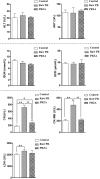Metabolomics reveals the mechanisms for the cardiotoxicity of Pinelliae Rhizoma and the toxicity-reducing effect of processing
- PMID: 27698376
- PMCID: PMC5048190
- DOI: 10.1038/srep34692
Metabolomics reveals the mechanisms for the cardiotoxicity of Pinelliae Rhizoma and the toxicity-reducing effect of processing
Abstract
Pinelliae Rhizoma (PR) is a commonly used Chinese medicinal herb, but it has been frequently reported about its toxicity. According to the traditional Chinese medicine theory, processing can reduce the toxicity of the herbs. Here, we aim to determine if processing reduces the toxicity of raw PR, and to explore the underlying mechanisms of raw PR-induced toxicities and the toxicity-reducing effect of processing. Biochemical and histopathological approaches were used to evaluate the toxicities of raw and processed PR. Rat serum metabolites were analyzed by LC-TOF-MS. Ingenuity pathway analysis of the metabolomics data highlighted the biological pathways and network functions involved in raw PR-induced toxicities and the toxicity-reducing effect of processing, which were verified by molecular approaches. Results showed that raw PR caused cardiotoxicity, and processing reduced the toxicity. Inhibition of mTOR signaling and activation of the TGF-β pathway contributed to raw PR-induced cardiotoxicity, and free radical scavenging might be responsible for the toxicity-reducing effect of processing. Our data shed new light on the mechanisms of raw PR-induced cardiotoxicity and the toxicity-reducing effect of processing. This study provides scientific justifications for the traditional processing theory of PR, and should help in optimizing the processing protocol and clinical combinational application of PR.
Figures




 ) Control group, (brown
) Control group, (brown  ) Raw PR group, (blue
) Raw PR group, (blue  ) PRZA group.
) PRZA group.



References
-
- The State Commission of Chinese Pharmacopoeia (2010 edition). The Medicine Science and Technology Press of China. Part I, 110 (2010).
-
- Wu X. Y. et al.. Sedative, hypnotic and anticonvulsant activities of the ethanol fraction from Rhizoma Pinelliae Praeparatum. J Ethnopharmacol 135, 325–329 (2011). - PubMed
-
- Zhou S. S. et al.. UPLC/Q-TOF-MS based chemical profiling approach to evaluate chemical composition of augmentation toxicity in combination of Radix Aconiti and Pinellia Praeparata. Acta Chim Sinica 70, 284–290 (2012).
-
- Wang Y. et al.. Quantitative analysis of flavonoids, alkaloids and saponins of Banxia Xiexin decoction using ultra-high performance liquid chromatography coupled with electrospray ionization tandem mass spectrometry. J Pharm Biomed Anal 88, 525–535 (2014). - PubMed
Publication types
MeSH terms
Substances
LinkOut - more resources
Full Text Sources
Other Literature Sources
Research Materials
Miscellaneous

